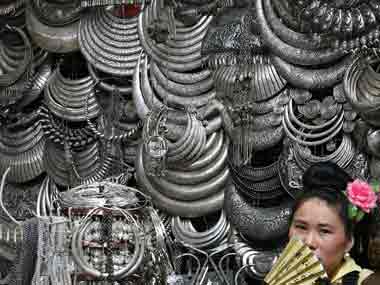• Asian stocks open mixed, with Shanghai and Hang Seng down by over a percent and Nikkei up by more than one percent, but the big news of the morning is the continuing plunge in silver prices - it’s now trading at $41.13 an ounce, down sharply from last week. What’s behind it? The third margin hike this week by the commodities exchange Comex, which has increased the cost of trading nearly 40%
[caption id=“attachment_4081” align=“alignleft” width=“380” caption=“Silver prices plunge due to increased trading cost. Reuters”]
 [/caption]
[/caption]
• Overnight, US equity indices were largely flat as investors sought safety in US Treasury bonds.
• Risk aversion is creeping higher, reckons market analyst Mitul Kotecha. “I’d caution about getting carried away with positioning for USD weakness. Whilst an imminent recovery looks unlikely, the risk/reward of shorting the USD is becoming increasingly unfavourable.”
• Back home, the markets reeled after yesterday’s rate hike, but there may be no immediate relief. But most brokerages believe there are more hikes in store, and have a negative outlook on the banking sector. Citi expects rates to go up by a further 50-75 basis points, which could bring growth down to 7.4%. RBS reckons banks will raise lending rates by 25-50 basis points, and loan growth is likely to moderate. It maintains a buy on SBI and HDFC Bank, and sees the NSE Nifty touching 5200-5300 levels. Standard Chartered sees banks’ profits profits declining by 12-20%; believes the sector will underperform for two quarters. Nomura believes inflation and rate hiking cycle has further to go, and maintains its ‘underweight’ rating for banks. HSBC sees repo rate going up to 8% by end-2011 and 8.25% by early 2012. It expects average inflation for FY2012 to be in the range of 8.3%. BNP Paribas too expects repo rates to be 8% by the end of the fiscal year, and GDP growth to be lower than envisaged by the RBI. Goldman Sachs reasons that the repo rate hike a hike in savings rate will mean that banks will have to hike their lending rate. A sensitivity analysis on various banks shows that banks’ profit before taxes could be anywhere between -0.4% to 36%.
• Within hours of the RBI move, IDBI Bank was off the mark first with a hike in lending rates: it increased its base rate (by 0.5% to 10%) and benchmark Prime lending rate (BLR) to 14%.
• Asset management companies are facing a squeeze. On the one hand, they’ve come under pressure from equity redemptions over the past few months. Now, the credit policy is compounding their problems: the central bank has imposed a cap (of 10% of networth) on banks’ investments in liquid schemes of funds. This was evidently done to stop circular movements of funds between debt-oriented funds and banks.
• Ranbaxy won a major reprieve, when an American court dismissed a petition from rival company Mylan challenging the former’s exclusive marketing right over the generic version of Pfizer’s Lipitor. Mylan had sued the US Food and Drugs Administration (FDA) for providing the exclusive right to Ranbaxy, alleging the permission has been given on falsified data. Ranbaxy is expected to launch the generic version of the drug on 30 November 2011 under a settlement deal with Pfizer.
• Construction companies could get a boost from the Road Transport Ministry’s plans to award projects covering 10,000 km of highways during the current financial year. About 80% of these would be awarded on the build-operate-transfer (BOT) mode. The government intends to reduce its annuity payments by awarding more projects under the BOT scheme.
• Is Sesa Goa being too presumptuous? The company notified stock exchanges that it had closed its open offer for shares of Cairn India, although the government is yet to give the go-ahead for the merger. A total of 155 million share, representing 8.1% of Cairn’s equity were tendered for a total consideration of Rs 5,503.7 crore. A council of minister meeting to decide on the deal was postponed, yet Sesa Goa continues to pump in money into the acquisition. It could turn out to be a very tricky.
)